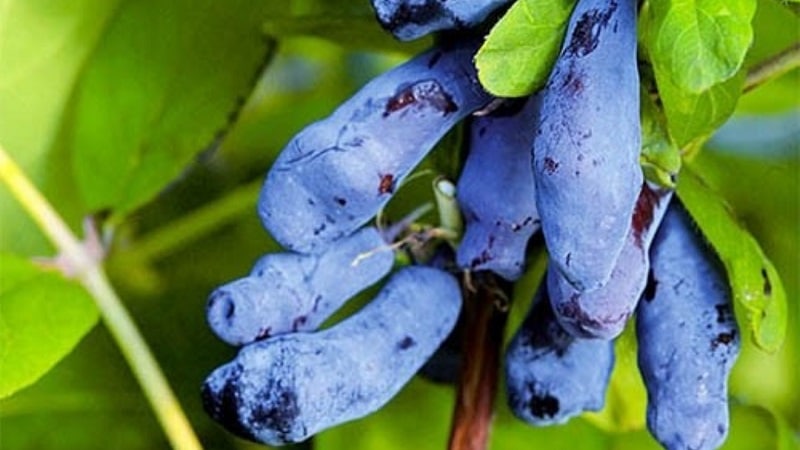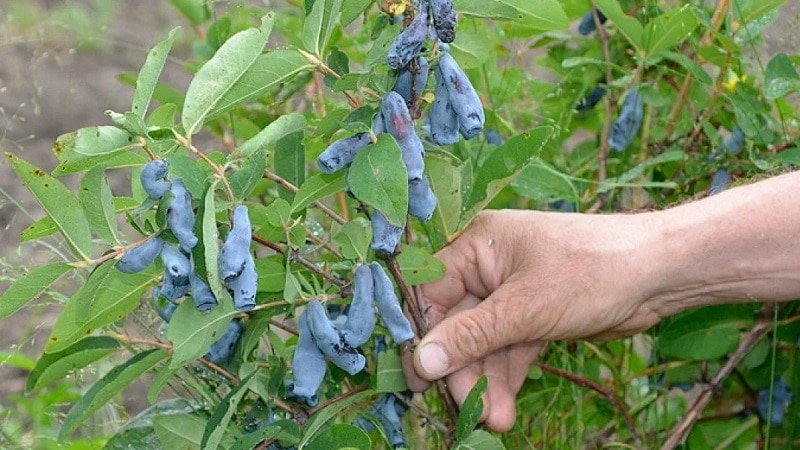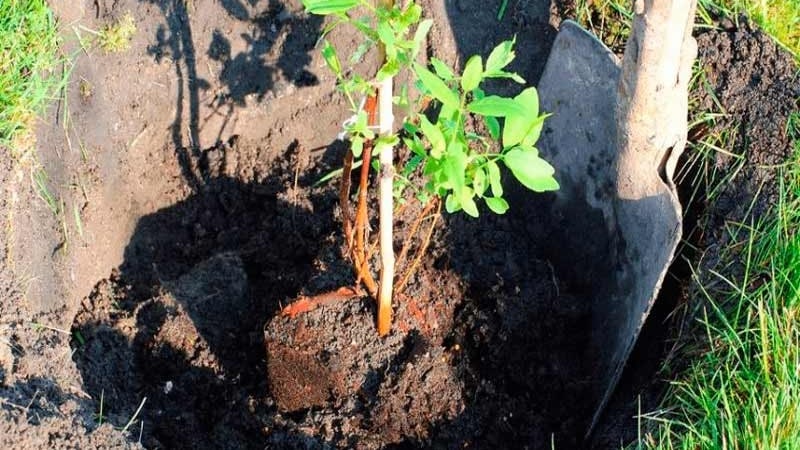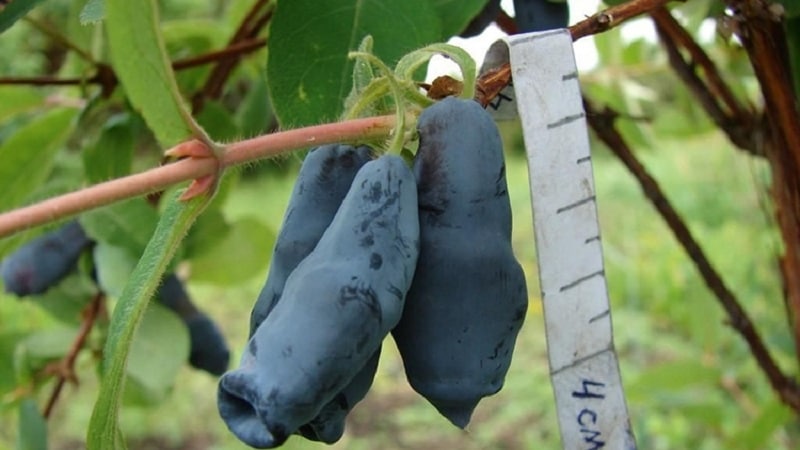Mid-late hybrid honeysuckle “Giant’s Daughter”
The Giant's Daughter is one of the most promising honeysuckle hybrids obtained recently. The culture was bred by domestic breeders and is characterized by frost resistance, good immunity and ease of care. We will talk about how to determine the timing of planting seedlings, select and prepare a site, and also analyze the basic agrotechnical requirements of the hybrid.
Description of the hybrid honeysuckle Giant's Daughter
This honeysuckle hybrid was bred by domestic breeders and is characterized by good frost resistance and large berries, 100 g of which contain 7.8% sugar, 2.6% acid and 43.2 mg% vitamin C.
Origin and development, history of breeding
Honeysuckle Daughter of the Giant was bred at the Federal State Unitary Enterprise "Bakcharskoe" as a result of crossing varieties Bakchar giant and Turchaninova. The hybrid entered the State Variety Testing in 2009 and was included in the State Register of Russia in 2017.

Characteristics, description of appearance, taste
Honeysuckle The Giant's Daughter forms vigorous-growing (height 8-9 years after planting up to 1.8 m), medium-spreading bushes with a medium-dense oval-shaped crown, erect grayish-brown hairless branches with peeling bark. Annual shoots are slightly pubescent, green with a crimson tint.
The leaf blades are medium-sized, green, matte, slightly pubescent, the flowers are pale yellow.
The berries are elongated, drop-shaped, covered with dark purple skin with a bluish waxy coating, weigh on average 1.8 g, but some specimens reach a weight of 2.5 g. The taste is sweet with a slight sourness.
Features of the use of this variety
The fruits of the Giant's Daughter are consumed fresh, ground with sugar, frozen and used for processing: making preserves, jams, and juices.
Ripening period, yield and fruiting
This is a mid-late ripening honeysuckle. Fruiting is extended, yield is 3.1-3.5 kg/bush or 69.4 c/ha.
Reference. The hybrid is classified as early-bearing, but the bushes produce marketable yields 5-6 years after planting.
Resistance to diseases and pests
The hybrid has strong immunity and is not susceptible to diseases and pests. However, if the bushes are not properly cared for, they can be affected by powdery mildew, leaf rollers, honeysuckle flies, scale insects, aphids and honeysuckle mites.
Resistance to cold and drought
The Giant's Daughter is a frost-resistant honeysuckle, it tolerates air temperatures down to -50°C, and fruit buds are preserved at temperatures as low as -40°C.
The bushes do not tolerate high humidity well - they develop slowly and may begin to rot. At the same time, the lack of moisture negatively affects the taste of the fruit - bitterness appears in them.

For which regions is it best suited and what are the climate requirements?
The hybrid prefers the climatic conditions of Central Russia, but, with the right approach and sufficient moisture, it grows and bears fruit well in the southern regions.
The Giant's daughter is included in the State Register of Russia with permission to grow in the Northern, Far Eastern, Northwestern, Central, Volga-Vyatka, Central Black Earth, North Caucasus, Middle and Lower Volga, Ural, Western and Eastern Siberian regions.
The main advantages and disadvantages of a hybrid
The main advantages of the Giant's Daughter:
- large fruit;
- pleasant dessert taste;
- annual fruiting;
- frost resistance;
- good immunity;
- weak crumbling;
- ability to bear fruit for 30 years;
- simple bush care;
- rich chemical composition.
Among the disadvantages of the hybrid are its self-sterility, slow growth in the first years after planting seedlings in open ground and uneven ripening of fruits.
What is the difference from other varieties and hybrids
Comparison of the Giant's Daughter with other mid-late varieties and hybrids of honeysuckle in the table:
| Variety | Average weight of berries, g | Taste | Berry color | Productivity, kg/bush |
| The Giant's Daughter | 1,8 | Sweet with sourness | Dark purple | 3,1-3,5 |
| Violet | 1-1,5 | Sweet and sour | Blue-violet | 2-3 |
| Velvet | 1,2 | Dark blue | 2,5 | |
| Berel | 0,4-1 | 3-4 | ||
| Fire opal | 1 | Blue-black | 3-5 | |
| Yugana | 1,4-2 | Dark purple | 3,5-6 |
Honeysuckle The Giant's Daughter: agricultural technology
Despite the unpretentiousness of the Giant's Daughter hybrid, in order to fully develop the bushes and obtain a rich harvest, it is necessary to plant the plants correctly and comply with the basic agrotechnical requirements of the crop.

Choosing a place in the garden and preparing holes
The Giant's Daughter is planted in a well-lit place, protected from gusty winds, located on a hill or plain. The depth of groundwater is 1 m.
Preparing for landing
When choosing planting material, preference is given to 2- or 3-year-old seedlings with a closed root system.They should have 2-4 even shoots and identical internodes. Before planting, plants are not pruned; only damaged branches are removed.
7-10 days before planting, prepare planting holes measuring 40 x 40 x 40 cm, add 10-20 liters of organic and 50 g of potassium and phosphorus fertilizers. Soil with high acidity is additionally limed or dolomite flour is added to it.
Soil requirements
Honeysuckle is undemanding to soil composition; only sandstones are not suitable, since they cannot provide the root system of the bushes with sufficient moisture.
The optimal acidity level is pH 5.5-6.6, acceptable is pH 4.5-6.5. If the soil is acidic, the risk of developing diseases increases.
Dates, scheme and rules of planting
Plants with a closed root system are planted throughout the entire growing season, and honeysuckle with open roots in late September-early October.

Planting pattern:
- Place a drainage layer of crushed stone, expanded clay or broken brick at the bottom of the prepared planting holes.
- Fill the holes one third with nutritious soil mixture (fertile soil, 20 liters of compost, 50 g of superphosphate and 1 kg of wood ash), pour 20-30 liters of water into each hole.
- Make a mound in the center of the hole, place a seedling on it, spread the roots along the slopes, fill the voids with soil so that the root collar is 3-4 cm above the soil surface.
- Water the plantings at the rate of 20 liters of water for each plant, mulch the tree trunk circle with straw.
Reference. The distance between rows should be 3-3.5 m, between bushes - 2.5 m.
Features of cultivation and nuances of care
Honeysuckle The Giant's Daughter is watered 4 times a season, pouring 10 liters of water under each bush.A day after watering, loosen the soil in the tree trunk circle to improve its moisture and air permeability and prevent the growth of weeds.
Fertilizers are applied every 3 years twice per season:
- spring - 10 kg of humus under the bush during digging;
- autumn - 150 g of wood ash under a bush.
Reference. During the formation of buds, foliar feeding is additionally used - the bushes are sprayed with “Master” or “Aquarin”.
Before the bushes are 3 years old, no pruning is carried out; only dry and damaged branches are removed. 4 years after planting, formative pruning begins: the 5 strongest shoots are left on the bush, extending from the center at the maximum angle, all other branches are removed at the root. Every year at the end of September they get rid of overgrowth, shoots growing inside the bush and old, dry branches.
For bushes aged 15-20 years, anti-aging pruning is carried out: all shoots are shortened to 15-20 cm.
Pollinators
Like other edible honeysuckle varieties, Giant's Daughter is self-sterile. To obtain a harvest, suitable pollinating varieties are planted nearby - Bakcharsky giant, Vostorg, Strezhevchanka.
Reference. Bees and bumblebees also help pollinate flowers.
Disease and pest control
Diseases and pests that can affect the Giant's Daughter:
| Disease/pest | How to get rid |
| Powdery mildew | Treatment with "Fitosporin" |
| Leafrollers | Spraying bushes with Confidor or Actellik preparations |
| Honeysuckle fingerwings | |
| Shields | |
| Honeysuckle mites | |
| Aphid | Before harvesting - spray the bushes with a solution of vodka (100 ml per 1 liter of water) 2-3 times with an interval of 7-10 days, after picking the berries - treat with Calypso or Aktara |

Preparing for winter
Daughter Velika has a high degree of frost resistance and can withstand air temperatures down to -50°C without additional shelter or special preparation for winter.
Reproduction
This honeysuckle hybrid is propagated in several ways:
- Seeds. The seeds are characterized by good germination, so it is not difficult to obtain plants, but in 80-90% of cases they lose their parental characteristics.
- Cuttings (green or lignified). In this case, the resulting plant inherits varietal characteristics, but the cuttings take root poorly and require labor-intensive care.
- By layering. There is a risk of damage to the cuttings during harvesting or loosening the soil, but the characteristics of the mother plant are inherited.
- Dividing the bush. Only strong, well-grown adult bushes are suitable for division; the divisions quickly take root in a permanent place and begin to bear fruit.

Harvesting
The berries begin to ripen in the 2nd decade of June. The harvest is harvested in 2-3 stages, manually separating the berries from the branches. In the refrigerator, at a temperature of 0...+3°C, the fruits are stored for a maximum of 3 days.
What difficulties may there be when growing
Honeysuckle The Giant's Daughter is an unpretentious plant with good immunity and a high degree of frost resistance, so growing it does not cause problems even for novice gardeners.
Difficulties include only the possibility of repeated flowering, which negatively affects subsequent yields. If we are not talking about industrial cultivation, then the buds are picked by hand as early as possible.
Tips and reviews from experienced gardeners about the hybrid
Gardeners recommend:
- plant tall flowers near the bushes to create the necessary shading for the lower shoots and maintain an optimal level of humidity;
- do not plant honeysuckle in lowlands - water often accumulates there, and excessive soil moisture is detrimental to the root system of the bushes.
They speak positively about honeysuckle Giant's Daughter:
 Ivan, Tambov region.: “Very pleased with this hybrid. The bushes require minimal care, they bear fruit consistently, the berries are large, aromatic and very tasty - sweet with a slight sourness in taste, which gives some piquancy.".
Ivan, Tambov region.: “Very pleased with this hybrid. The bushes require minimal care, they bear fruit consistently, the berries are large, aromatic and very tasty - sweet with a slight sourness in taste, which gives some piquancy.".
Ekaterina, Rostov-on-Don: “The seedlings were given to us by relatives from Tomsk. After planting, the plants did not grow for a long time, they looked weak, but then they still adapted. Now these are mature bushes that annually delight us with a fairly large harvest of delicious berries. It’s not difficult to care for the Giant’s Daughter, the fruits are delicious, we eat some fresh, and some we use to make jam.”.
Conclusion
The Giant's Daughter is a young honeysuckle hybrid that is steadily gaining popularity among gardeners. It has such advantages as good immunity, high frost resistance, large fruit and a pleasant taste of berries. The only disadvantages include the need for pollinating varieties and uneven ripening of the crop.